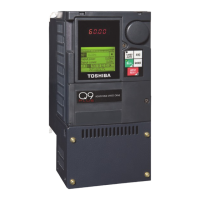Alarms, Trips, and Troubleshooting
Q9 Plus ASD Install/Op Manual
https://www.toshiba.com/tic/ 267
Trips
A Trip is an ASD response to a Fault (though, Fault
and Trip are sometimes used interchangeably). A
Trip is a safety feature that disables the ASD system
in the event that a subsystem of the ASD is
malfunctioning or a parameter setting has been
exceeded.
Listed in Table 18 are Faults that may be displayed
at the EOI and the possible causes. When a Trip is
incurred, the system displays the Fault screen. The
Fault screen displays the active Fault.
Note:
See FC90 of the Q9 Plus ASD for the
communications error code number of
the active fault
.
Table 18. Fault Codes
LED
Screen
LCD
Screen
Fault Description Possible Cause
Note: The event that caused the trip(s) must be corrected or must decrease to less than the
threshold value required to cause the trip to allow for a Reset to be recognized. In the event
of multiple active trips, the trip displayed will remain until all faults are corrected and
cleared.
AbFL
Low Suction/No
Flow Cut Off
Running ASD producing no
flow.
• Low Suction/No-Flow Trip enabled at F450.
• Loss of suction pressure or closed pump output
valve.
• Activated discrete input terminal set to Low
Suction/No Flow Protection.
• Pump cavitation.
• ASD Upper-Limit Frequency run-time is equal to
F484 time setting.
E Emergency Off
Emergency Off command
received via keypad or
remotely. Output signal from
the ASD is terminated.
• Stop-Reset was pressed twice at the EOI.
• E-Off command was received remotely.
• Select stopped method at F603.
E-10 Analog In OV
Analog input terminal over-
voltage.
• Mis-wire at the ASD input terminals.
E-12 Encoder Loss Encoder loss. • Encoder signal is not received.
E-13 Over-Speed Speed error (over-speed).
• Result of a motor speed that is greater than the
commanded speed when using an encoder for
speed control.
• Improper encoder connection or setup
information.
• Defective encoder.
E-18 Analog In Loss Analog input loss.
• V/I input terminal configured for operation but the
voltage/current input is either missing or low.
• Over-current at P24.
E-19 Abnormal CPU2
Abnormal CPU2
communication.
• Contact TIC Customer Support Center.
E-21 Stack Err Stack overflow error. • Contact TIC Customer Support Center.
E-22 Discrete In Volts
Improper input voltage level
at discrete input terminal.
• Discrete input terminal configured for operation
and the input activation voltage level is out of
specification.

